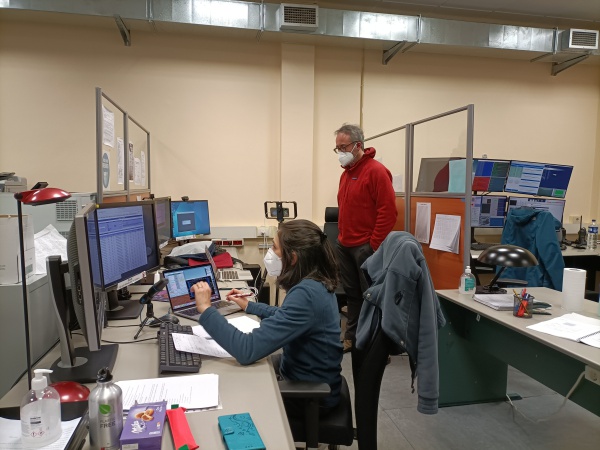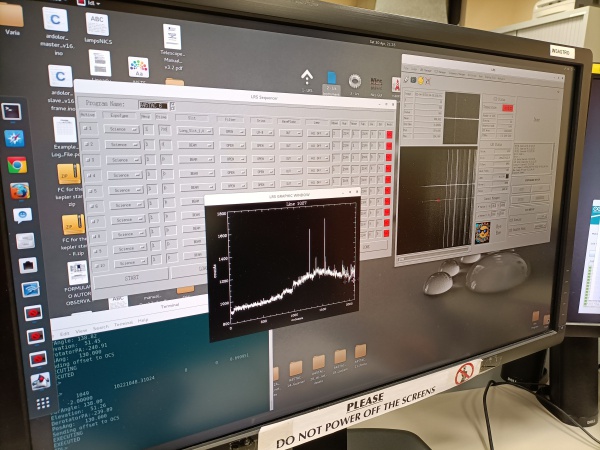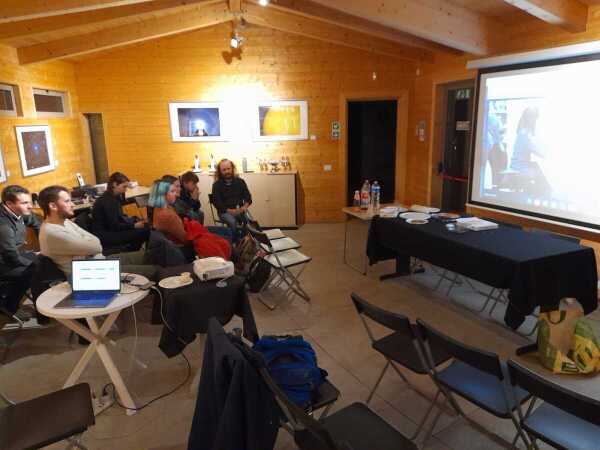TNG and the University of Florence
On April 30, 2022, a group of eight students of the University of Florence, Italy, together with one of their professors (Marco Romoli), attended a virtual visit to the Telescopio Nazionale Galileo (TNG) and afterwards remotely participated in a scientific observing night, being connected in videoconference from the Osservatorio Polifunzionale del Chianti, a research, teaching and outreach facility of the University of Florence located in the Chianti countryside in Tuscany, Italy.
The virtual visit was conducted by Dr. Gloria Andreuzzi and started before the sunset in La Palma: students could listen to the explanations by Dr. Andreuzzi while watching the telescope from outside and from inside the dome. Later the videoconference resumed from inside the TNG control room, where students were introduced to the various facilities and could watch all the preliminary operations of a scientific observing night, like the focusing of the telescope thanks also to Albar Garcia de Gurtubai, telescope operator for that night.
As soon as the sky got sufficiently dark, the scientific observations started, with the students still connected in videoconference. The targets of the observations (part of a project led by Dr. Filippo Mannucci of INAF-Osservatorio di Arcetri) were objects previously catalogued by the Gaia astrometric satellite and thought to possibly be remote galaxies, each hosting two supermassive black holes at its center. The aim of the observations, conducted by Prof. Elisabeta Lusso with Dr. Andreuzzi as support astronomer, was to collect spectra of the objects with the instrument DOLORES through the LR-B grism, in order to detect the signatures of the nuclear activity connected with the presence of supermassive black holes, with masses of millions or even billions of suns, accreting matter on themselves. Students could follow the observations and interact with observers who explained them in detail what was going on. In the coming weeks, thanks to an agreement with Dr. Mannucci, who also gave a lecture to the same students in Florence to explain the scientific background and objectives of the observations, the students will have the possibility to reduce the acquired data during laboratory sessions. The interactive connection remained open for nearly four hours after the start of the observing run. Prof. Lapo Casetti, also present at the TNG, acted as coordinator of the teaching part as well as second visiting observer together with Prof. Lusso.
These activities are part of a collaboration between the TNG and the Department of Physics and Astronomy of the University of Florence started in 2017, aiming at offering students enrolled in the "Physics and astrophysics" (Laurea) and "Physical and astrophysical sciences" (Master) programs and attending the "Complementi di astronomia" course (taught by Profs. Romoli, Lusso and Casetti) a complete experience of how observational research in astrophysics is carried out at the professional level. Although this year the activity was slightly different and the observations were part of an actual scientific program, in the past years students participating in this activity proposed, planned and performed the observations themselves, using state-of-the-art instrumentation as the TNG and its focal plane instruments and exploiting the typically excellent observing conditions of the Roque de Los Muchachos observatory, and then reduce their own data, as professional astronomers (as some of them will hopefully become) would do.
In 2017, 2018 and 2019 other groups of students had the unique opportunity to carry out the observations in person in the control room of the TNG, thanks to the financial and logistic support of the Department of Physics and Astronomy of the University of Florence and of the Fundación Galileo Gailei-INAF, with additional financial support from INAF-Osservatorio astrofisico di Arcetri through a private donation from the Magini family. The activity had been scheduled also for 2020, but the COVID-19 pandemic outbreak made the observations impossible. In 2021, despite the ongoing pandemic, it had been possible to resume the activity, although only remotely, with Dr. Andreuzzi carrying out the observations at the TNG and the students connected in videoconference. Hopefully in the next years, after the end of the pandemic, students participating in this program may find themselves again not only observing from the TNG control room but also looking at the Milky Way under the pristine sky of the Roque de Los Muchachos.




